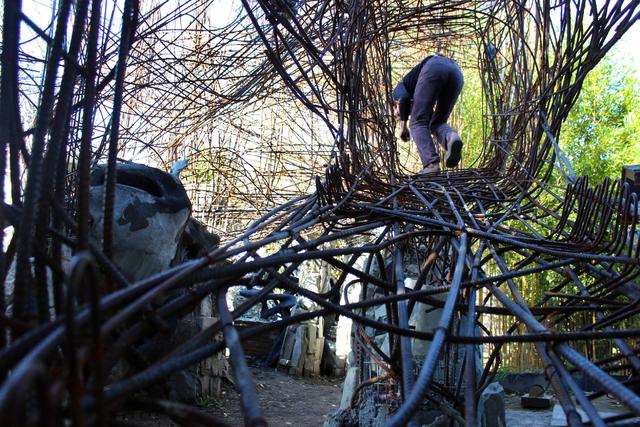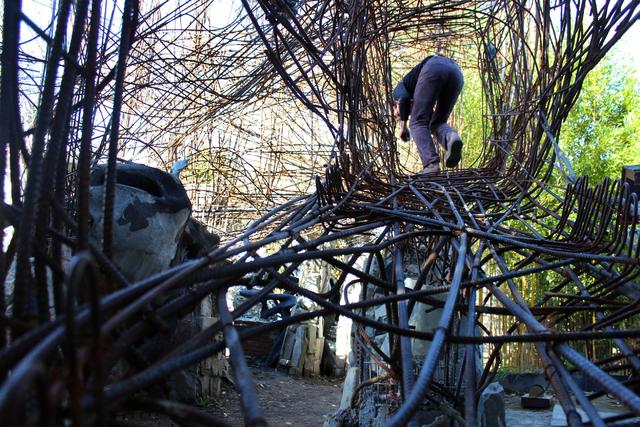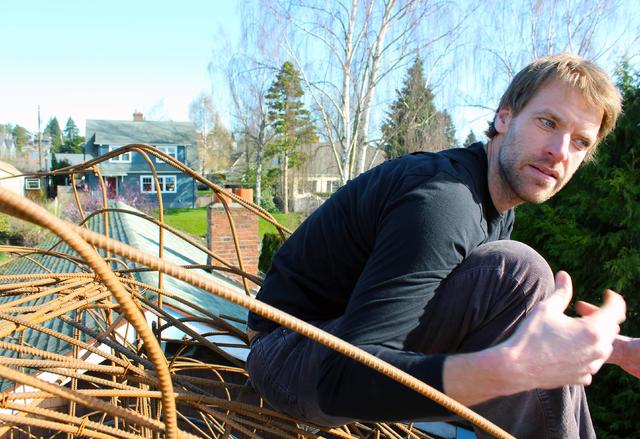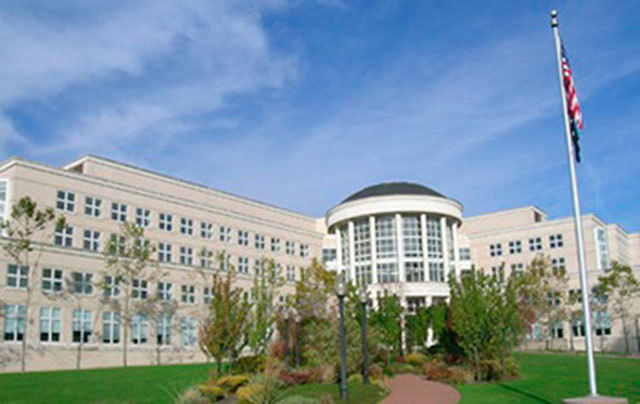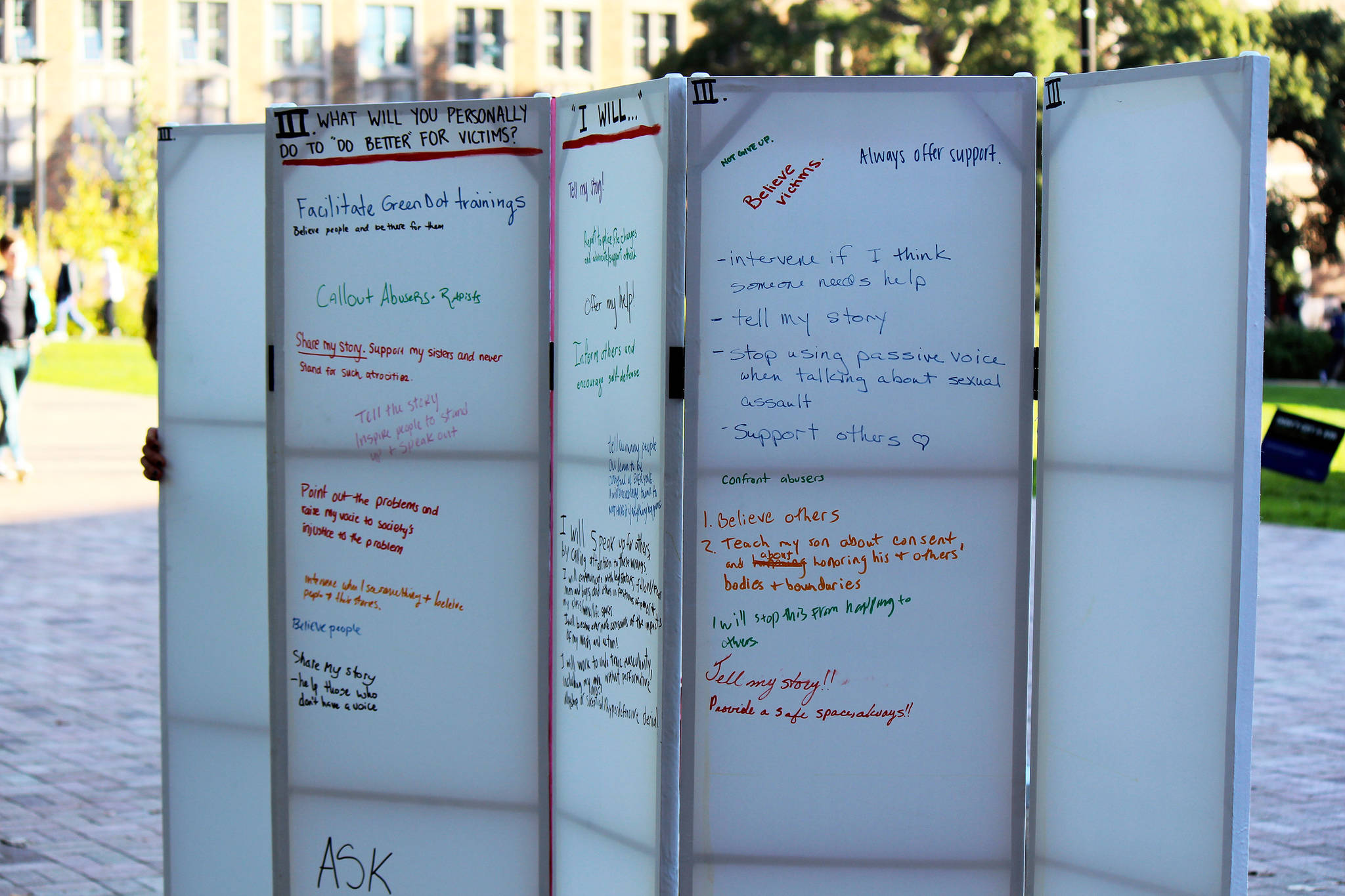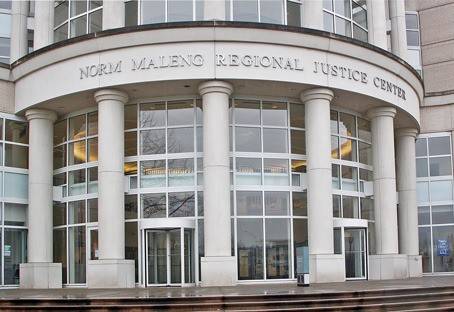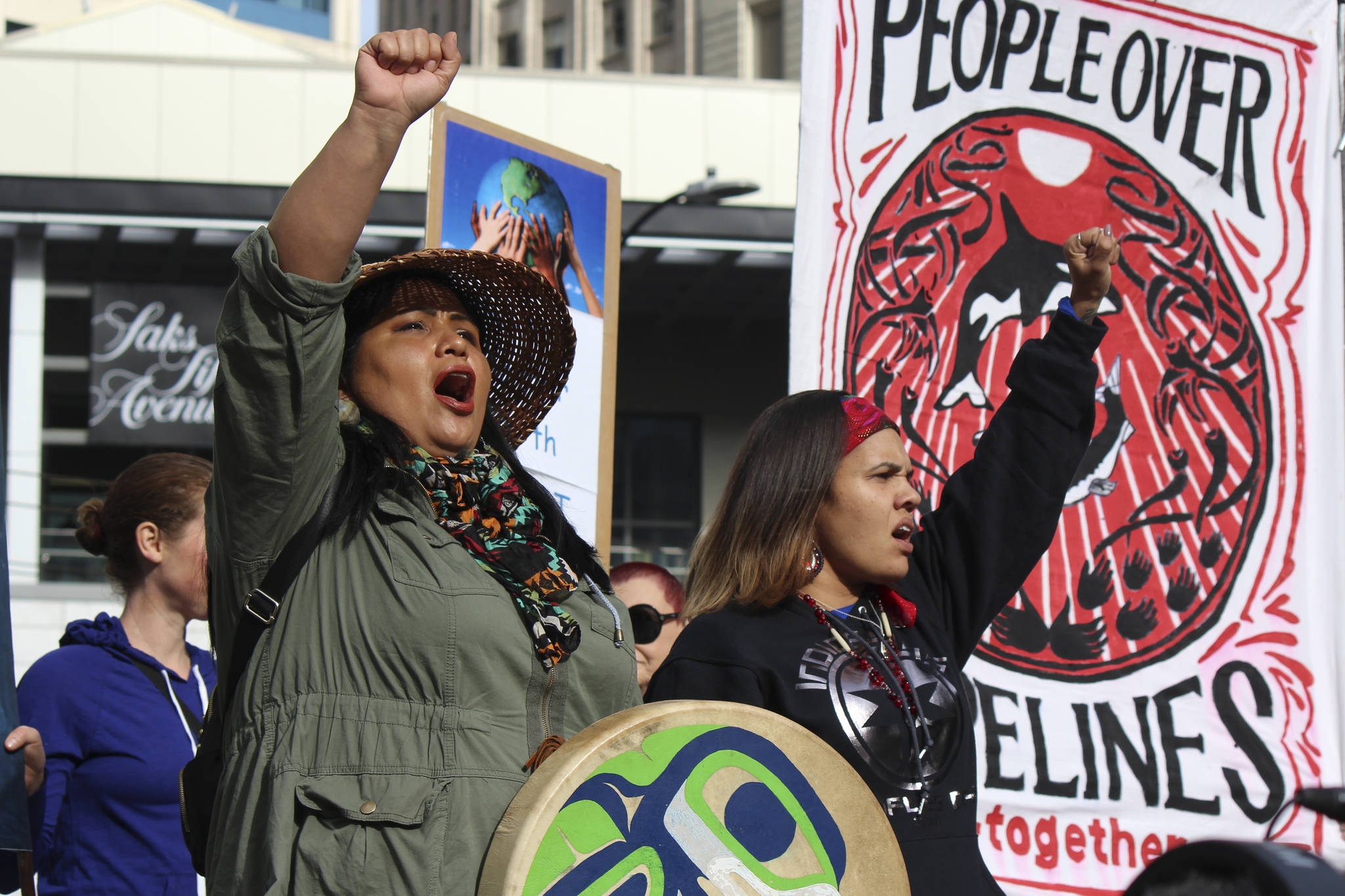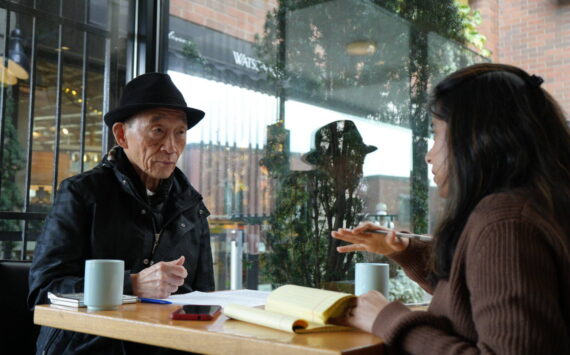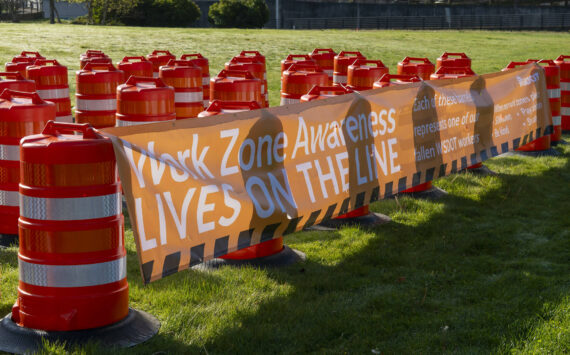Out of a small backyard in a cheery West Seattle neighborhood near California Avenue Southwest and Southwest Charlestown Street grows a half-built magical kingdom known as the Undersea Aviary. It’s made of rebar and wire mesh, bone-white mortar and colorful tiles, with curving ocean grottoes, banks of coral, sea anemones, and a giant squid with curling tentacles. Mirror mosaics reflect light in a glitter of rainbows; a giant sperm-whale maw with iron teeth curves up like a spiral staircase into the air, ending at eye level with the rooftops of neighboring houses.
“There would have been some sort of rock lobster, a 20-foot long crustacean of some sort, and you’d climb up through him in some way, and get up to here, where there would’ve been be a railing,” explains homeowner and visionary Michael Henderson as he deftly scrambles up the naked web of rebar. “And then there would’ve been a final tower up top” with water streaming through various holes in the mortar and cascading into a pond at ground level. The end goal was to create a fantastical public-art playground for kids, something he says could have marked a renaissance in public playgrounds.
He heaves a sigh. “Oh, this would have been fun.”
He says “would have” because, for the time being, a lawsuit has put this dream on hold.
“Theoretically they could bury me, still,” says Henderson—“they” being the City of Seattle, with whom he’s been at odds since July 29, 2015. That was the date the Department of Construction & Inspections (DCI) issued a Stop Work Order and then, the following day, a Notice of Violation.
The structure is too tall, too wide, and has too deep a foundation to exist without a city building permit, which requires detailed blueprints, the official sign-off of a structural engineer, and sensible limits on size and breadth, among other things. City land use code stipulates that only 35 percent of a 5,000-square-foot lot in a single-family zone can be covered in a structure, whether that’s a house, a backyard shed, or an Undersea Aviary.
It’s been nearly seven months, and Henderson has yet to submit any documents to the city. At first he ignored the order, essentially telling inspectors, “When it’s done, you’ll see! It’ll be cool, it’ll be fine, it’ll work out; I can’t stop.” He kept building seven days a week, despite the hot-pink Stop Work Order taped to the front of his house. So the DCI referred the case to the city attorney’s office, which brought the lawsuit. He could technically be fined $500 a day for each day past the DCI’s original deadline that the structure is either torn down or properly permitted. With mitigation hearings ongoing, though, nothing is certain.
Henderson did begin to have conversations a few months ago with city employees about how to legally proceed. For instance, he could, and very well may, take down a third of his house to meet the 35 percent land-use requirement. But secretly, he hopes—and almost believes—that they’ll change their minds. “I think they’ll be OK about it,” he says. “I’ve gone to court like three times now. This last time, they were like, ‘People are still complaining. You’ve got to take it down. This is the last month we can give you.’ But even then … I’m like, ‘OK, I’m getting together a fundraiser, we’re going to make this work.’ ”
Henderson just launched a Kickstarter campaign to fund the planning, design, and construction of Undersea Aviary 2.0—which could succeed, as the sheer wonder and whimsy of the project has drummed up a sizable community of sympathetic builders and artists, some of whom Henderson hired to help put it together last summer.
He needs to raise money now, though; he’s been funding the project for the past few years on savings alone. He hasn’t had a day job for years, and living off side gigs redoing people’s bathrooms and what’s left in the bank isn’t cutting it anymore. “I’m going to be bouncing checks heavy in March!” he says, laughing. “It kind of has to happen, which I think is good. Desperation is fertile ground.”
Henderson adds with a twinkle in his eye that all the city inspectors involved have put on pretty good poker faces throughout this whole thing. “But I can tell: They’re cheering for me.”
Henderson is tall and lithe, with clear blue eyes and sandy hair, and on a recent afternoon wore thick workboots, brown corduroys, and black suspenders with one clip undone. He speaks in smooth, pensive tones, and within minutes launches into his own story, and the painful intricacies of the human psyche. “My kiddo’s mom and I, we split three years ago, before this got rolling,” he says. “I can only assume that the two are deeply related.”
Henderson is a licensed architect; he’s a talented craftsman and self-described workaholic, and says he has a dozen reasons for attempting such a feat. But fundamentally, he characterizes the construction of the Undersea Aviary as a form of peacemaking with himself: It was a way to officially embrace his own eccentricity.
“I think that when my very reasonable, normal wife left the picture, I felt like … there was my cover, it was blown,” he says. “I think I was trying to blend. I think when you have kids, you try to blend even harder. I think there was a point when I was like, oh, fuck, it’s just not possible!”
He recalls his own reaction, once, to carrying a Netflix envelope to the post office. “I remember thinking to myself, ‘This is a very normal thing to do. People get Netflix.’ I was comforted that I was walking with a red Netflix envelope! You know? It’s crazy!” And losing a long relationship, he says, helped him to see that anxiety with clarity, to relax into himself, and to let go of the ideas about normalcy he was holding onto. “You know how when a really long relationship ends, you feel like the bottom gets pulled out of your life? But, you know … there’s no bottom. There never was.”
Henderson says that the “scarlet letter” of the Stop Work Order has changed his relationship with the neighborhood, though. “Neighbors give me just a little more distance. It’s very subtle. It’s interesting.”
With some neighbors, it wasn’t as subtle. “It did get unfortunate with my neighbors here,” he says, pointing to a window whose view is beginning to be obstructed by a tower of rebar. “I’d be up here working, and they’d yell out their window: ‘We’re calling it in again!’ That part sucked. And there was this feeling, like, ‘Oh no, just wait! You’re gonna love it!’ ”
Henderson is certainly not the first homeowner to be called in by his or her neighbors. But that usually happens when “someone’s put a little bump out on their house without a permit, ” says Bryan Stevens, customer-service manager at the Department of Construction & Inspections. “I haven’t run across anything quite like this in my 15 years with the city.”
Henderson claims he understands the neighbors’ concerns and the city’s efforts. “I get it, you know.” He pauses, sighs. Then, suddenly giddy: “Oh, but it would’ve been … plants spilling out of there, all of these flying buttresses on the outside … Oh, it would’ve been fun! But the next one will be even better.”
The name “Undersea Aviary” is based on a story Henderson dreamed up. In fact, the whole structure has a story, centered on a fictional submarine captain—“Admiral Mandible”—who lives underwater but wants the sea creatures to see the birds.
“Maybe there’s a metaphor there,” he says. The story is ultimately about the idea of belonging or not belonging—about eccentricity and normalcy. An aviary doesn’t belong in the ocean, “but all the sea creatures are glad it’s there.”
Henderson is remarkably calm. This project is “like a migrating bird, or something,” he says. “You track it and watch it and you make field notes, but, you know, after it’s gone, it’s gone. It feels much more appealing to take it down and see what comes next. This was always a beginning.”
Sara Bernard writes about environment and education, among other things, for Seattle Weekly. She can be reached at sbernard@seattleweekly.com or 206-467-4370. Follow her on Twitter. Get more from your favorite writers by subscribing to our weekly newsletters.
